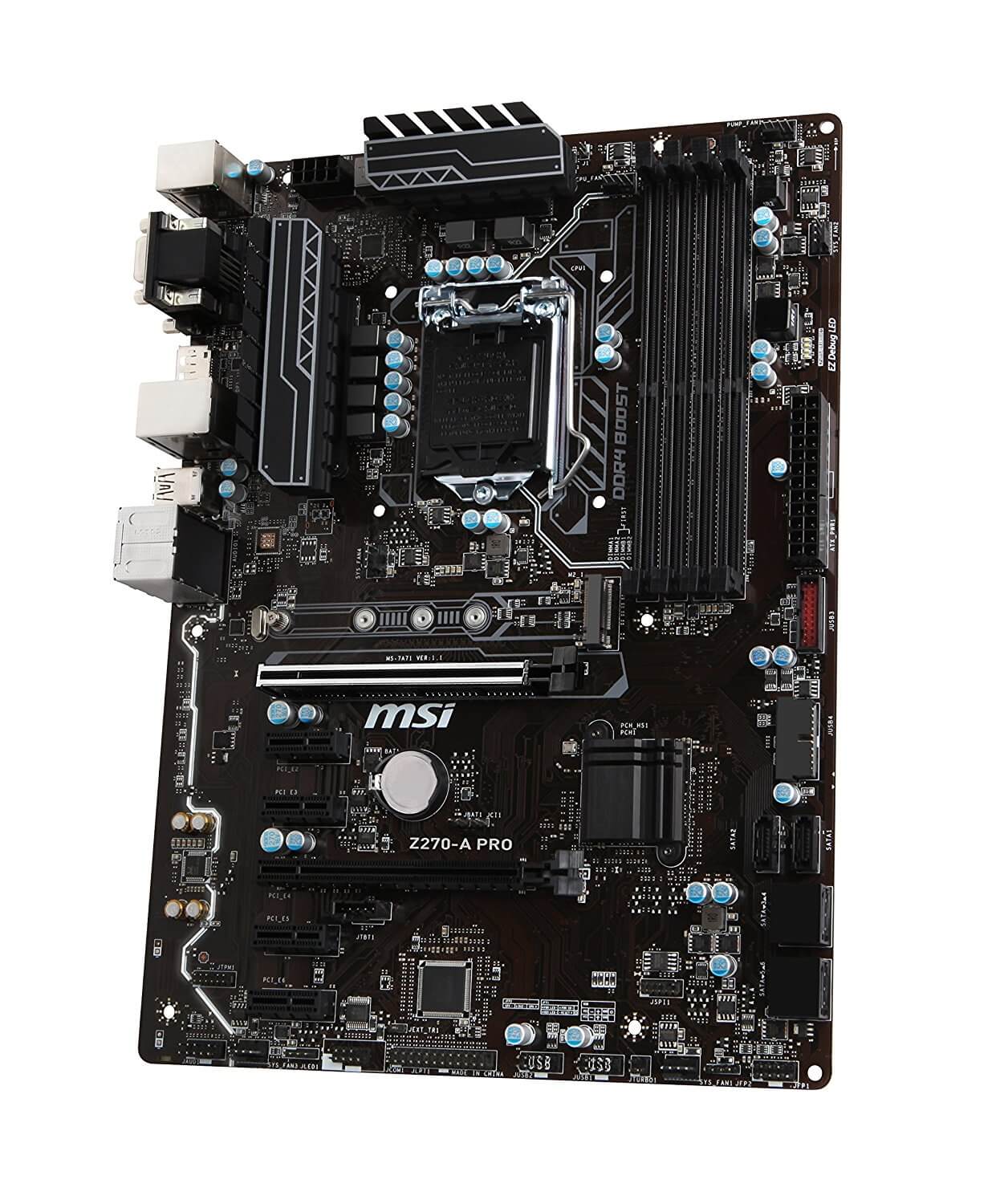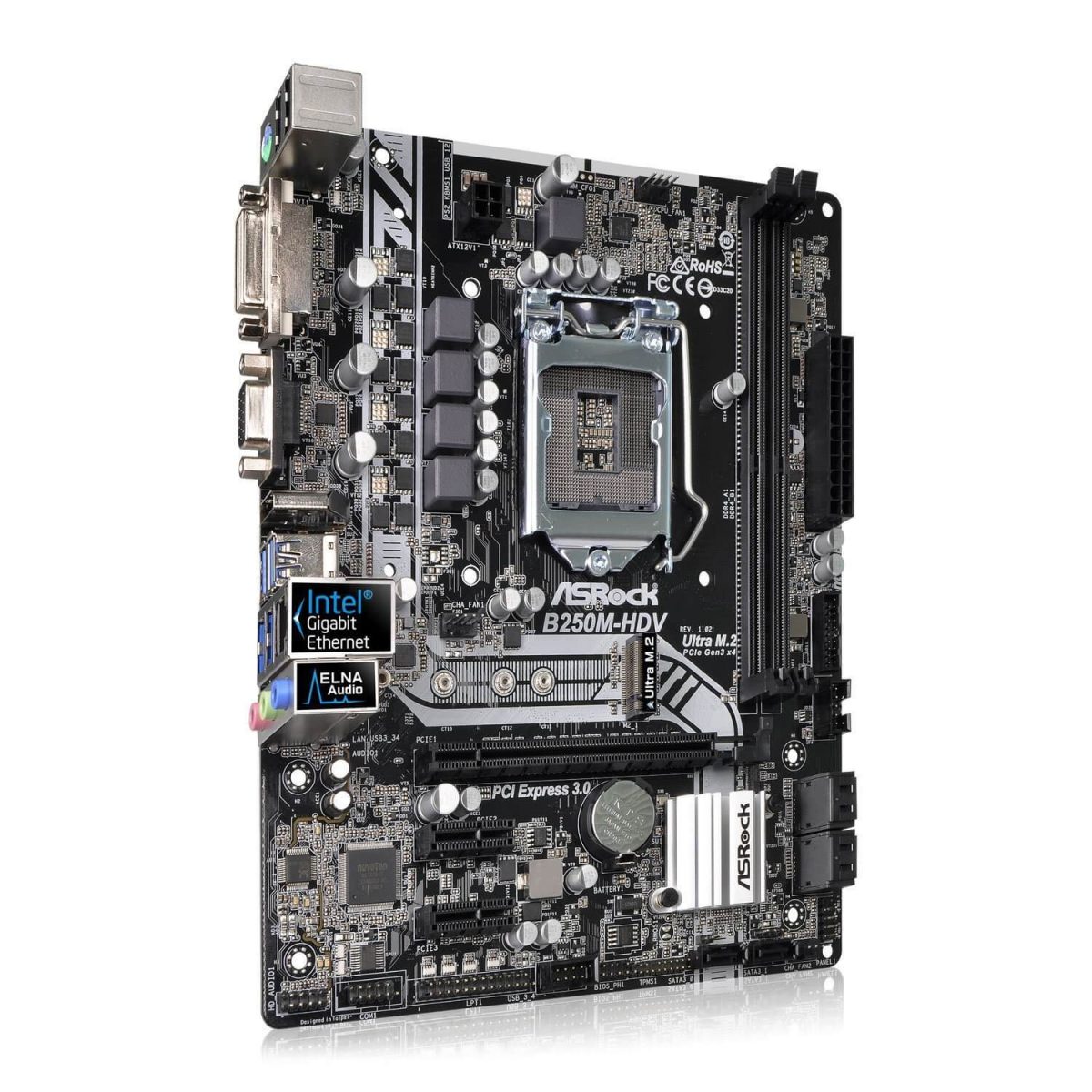Best i7-7700K motherboards of 2018 – Buying Guide
Intel’s i7 CPUs have been dominating performance charts from the moment they launched in 2008, and have been the processors of choice for gamers, hardcore multitaskers, and people that needed tremendous amounts of processing power ever since. They are Intel’s top-of-the-line processors for the general audience, being outperformed only by server-grade CPUs (Xeon) and Intel’s own enthusiast-series (Intel Extreme), both of which are lineups targeted at entirely different user segments. In their own segment, i7 processors had no real competition up until recently when AMD launched Ryzen.
The i7-7700K is Intel’s seventh implementation of i7, and is based upon the Kaby-Lake architecture, which is basically a refresh of the Skylake architecture that pushes the 14nm fabrication process even further. At the time of writing, the i7-7700K is Intel’s most powerful mainstream CPU, and the option of choice for Intel fans building a high-end rig. Out of the box, the processor has an operating frequency of 4.2GHz, which goes up to 4.5GHz thanks to the Turbo Boost technology. However, being an unlocked CPU, its special feature is its overclocking potential – paired with a good motherboard, the i7-7700K can blow past the 5GHz barrier without much
What is a good motherboard for the i7-7700K, you ask? For starters, it needs feature the Z270 chipset, as anything below that will limit the processor in some way. That still leaves you with plenty of options to choose from, but worry not, as we took it upon ourselves to go through the plethora of motherboards out there and select only the very best. Here are the best motherboards for the i7-7700K.
Best Overclocking Option – ASUS Maximus IX Apex
The ASUS Maximus IX Apex is a motherboard aimed at overclocking enthusiasts that want to push their components to the limit. Everything about it is designed with performance and customizability in mind.
Design
At a first glance, the ASUS Maximus IX Apex may not seem that imposing – it doesn’t have the thermal armor present on the SABERTOOTH models, nor the huge waterblock of the Maximus IX Extreme, and you might mistake it for just another ASUS motherboard. The Maximus IX Apex is anything but “just another motherboard”. Look at it for more than a second and you will notice that it’s big: Extended-ATX-big, to be precise. Then it’s its shape: the angled elements inspired by the F-117 Stealth Fighter Jet, paired with the X-shape asymmetrical design of the board give it a really unique feel. Last but not least, there are some customizable 3D-printer-friendly elements that are integrated with the Aura Lighting feature, allowing you to customize the cutouts and light effects to make the motherboard stand out like no other.
Hardware and Features
While the Maximus IX Apex may have some competition in terms of design, it absolutely crushes everything in its path in terms of performance. The first clue is given by the CPU power connectors: the board comes with 2 x 8pin connectors, an indicator that the board can drive a CPU to impressive frequencies without being bottlenecked by a lack of power. The hefty cooling on the VRMs around the CPU socket along with the numerous controls for a fine-adjustment of the overclocking settings should further indicate that the Apex does not mess around, but if you’re still not convinced, a look at the numbers will do the trick for you: the ASUS Maximus IX Apex managed to push an Intel i7-7700K to a mind-blowing 7383MHz at the ASUS ROG Absolute Zero event, setting a still-standing world-record for this CPU in the process. 7383MHz. Let that number sink in.
Another standout feature of the ASUS Apex is the DIMM.2 slot. Simply put, the DIMM.2 module is an add-in card that fits on a specially-designed DDR4 slot, and can support two M.2 drives, providing them with blazing speeds and proper cooling.
Connectivity
The connectivity side is rich but not out of the ordinary. Wi-Fi and Bluetooth connectivity are missing, but everything else is there.
Best Feature-Rich Option – Gigabyte GA-Z270X-Gaming 9
The Gigabyte GA-Z270X-Gaming 9 has the looks, the performance, and the features to satisfy everyone’s needs. Whatever it is you’re looking for in a motherboard, chances are the Gaming 9 has it.
Design
Gigabyte managed to bring a much-needed design refresh to its boards with the introduction of its Aorus line, and the Gigabyte Aorus Gaming 9 is the perfect example. The board looks big both due to its format (Extended-ATX), as well as due to the massive hybrid heatsink that cools the VRM area, large chipset heatsink and the gigantic shield that stretches all the way along one of the sides of the card. Gigabyte opted for a neutral color scheme with a black PCB with some silver and white elements, and a drop of color in the shape of the Aorus logo, which makes the board fit in nicely with any color theme you might have in mind for your build. The board really shows its strength in the aesthetics department once you power it on, though: it has 6 different fully-customizable RGB light zones – enough to put your Christmas tree to shame.
Hardware and Features
Great looks is not everything the Gigabyte GA-Z270X-Gaming 9 has going for it – the card also features some exciting hardware features. The hybrid cooler on the VRM area provides some serious cooling, whether you go for air cooling or water cooling, meaning the VRMs won’t have any issues if you opt for some serious overclocking, which is quite easy to accomplish due to the diverse overclocking controls present on the motherboard. It’s not only CPU horsepower that received special attention, though – one of the most notable features of the Gigabyte Gaming 9 is the addition of a PEX8747 chip that boosts the number of PCI Express lanes to the CPU to 32, allowing for unparalleled performance in SLI or Crossfire configurations (up to 4 cards!).
On the audio side, the Gaming 9 comes with an award-winning ZxRi chip that features a 120+dB certification, along with 2 hardware amplifiers.
The storage department wasn’t neglected either, the card supporting M.2, U.2 and Gen3 x4 NVMe PCIe SSDs, along with the usual SATA drives support.
Connectivity
When we mentioned that the Gigabyte Aorus Gaming 9 has it all, we weren’t kidding. The list is so extensive that we won’t even post it here. You can find the connectivity options, as well as all other specs of the Gigabyte Gaming 9 here.
Best mini-ITX option – ASRock Fatal1ty Z270 Gaming-ITX/ac
Some people like their rigs to be big and imposing, others want them to be small and discrete. If you fall into the latter, and want a small motherboard that still incorporates a lot of features and power, the ASRock Fatal1ty Z270 Gaming-ITX/ac is it.
Design
Designing a mini-ITX motherboard is a challenge in itself, but having to design a mini-ITX motherboard for high-end builds is even harder. Harder doesn’t mean impossible, though, as the ASRock Fatal1ty Z270 Gaming-ITX/ac clearly demonstrates. Despite its small size, the Fatal1ty Gaming ITX/ac incorporates all the hardware essentials needed for such a build, and also looks good in the process. The board features a red-black color theme, with a black PCB and red accents on the RAM slots and chipset/VRM heatsinks. LED lighting is not present, as such motherboards are mainly used in small builds where the other components usually obstruct the visibility of the motherboard, so such feature would have been a fairly useless addition.
Hardware and Features
Hardware-wise, the ASRock Fatal1ty Gaming-ITX/ac is ready to take on other Z270 motherboards without much effort. Thanks to the use of high-quality components such as the 60A power chockes and the dual-stack MOSFETS, the board has some more-than-decent overclocking potential, having no trouble pushing an Intel i7-7700K past the 5GHz barrier. RAM overclocking is also possible, so with a bit of tinkering and a good kit of RAM, you should be able to push it above 4000MHz.
In terms of storage, the ASRock Fatal1ty Gaming-ITX/ac comes with 6 SATA ports, 1 SATA Express and one Ultra M.2 slot, which should give you plenty of options – probably more than the case will be able to handle.
Connectivity
Whether you plan to use the ASRock Fatal1ty Gaming-ITX/ac in a gaming build, a HTPC setup or anything in between, you’ll notice that the board has all the connectivity features you may need for any usage scenario. The board comes with 6 x USB 3.0 ports, 1 x Intel Thunderbolt 3 port (USB-C compatible), 1 x DisplayPort, 1 x HDMI port, 7.1 channels audio + optical output and 2 Wi-Fi antenna ports. Impressed? You should be.
Best Overall Performance – ASUS Maximus IX Hero
The ASUS Maximus IX Hero is a card for those that want great all-around performance. It has the looks, ASUS’ renowned quality and a decent price tag to go with it – a combination you can’t go wrong with.
Design
ASUS is known to go with attention-grabbing designs for their high-end motherboards, usually making use of shields that cover large area of the PCB or highly contrasting color schemes (usually black and red). In the case of the Maximus IX Hero, though, ASUS seems to have opted for a more subtle approach, the card coming with a mostly-black color scheme, and no elements that jump in the eye. That does not mean that the IX Hero is not good looking – au contraire, the board has a subtle yet elegant feel to it, thanks to its large and well-designed heatsinks. The Maximus IX Hero has multiple 3D printer-friendly elements that allow customization, and 2 areas lighted with RGB LEDs. Aura Sync technology is also supported, so you can further extend the lighting options with other Aura-compatible components.
Hardware and Features
On the hardware side is where the ASUS Maximus IX Hero shows its true strength. The board boasts all the features you come to expect from a high-end ASUS product. Overclocking on the Maximus IX Hero is quick and straightforward thanks to the ASUS Dual Intelligent 5-Way Optimization feature, which brings all the tools you need in one place. Its storage options include 6 SATA ports as well as two M.2 slots with support for various RAID configurations and support for Intel’s Optane Technology.
The audio side was not neglected either, the Maximus IX Hero featuring ROG’s SupremeFX 8-channel audio chip that delivers crystal-clear sound and numerous enhancement options.
Connectivity
The I/O panel of the ASUS Maximus IX Hero features all the regular options: USB 3.1 (Type-C and Type-A), LAN, HDMI, DisplayPort, and even dedicated buttons for clearing CMOS settings – especially useful when overclocking. Wi-Fi and Bluetooth connectivity is missing, but that shouldn’t be a deal-breaker.
Best Value Motherboard for i7-7700K – MSI Z270-A PRO
The MSI Z270-A PRO is a board that caters for budget builders. It features the full power of the Z270 chipset without all the extra bling, which reflects in its price tag – the board can be yours for only $115.
Design
As you can expect from a budget board, its design is nothing to brag about. The board comes with a black PCB, the only elements that stand out a bit being the metallic silver PCI-Express slot, the black and white design of the (fairly small) VRM heatsink and the white circuit that physically delimitates the sound card form the rest of the PCB. There are no large heatsinks or shields, no blinking lights and no other fancy features, but as mentioned before, this card is not meant for show-offs.
Hardware and Features
The hardware side of the MSI Z270-A PRO is basic but well-balanced. Despite the fact that it only comes with a 4+2 power phase design, which is not exactly the ideal setup for serious overclocking, the Z270-A PRO should still be able to push the CPU a bit thanks to the use of quality components, as confirmed by the MSI Military Class 5 certification. Memory support is officially listed up to 3800MHz, but some overclocking should be possible in that department as well.
When it comes to storage, the MSI Z270-A PRO features the usual 6 SATA ports, but only one M.2 port. This is still enough for simpler setups, with one ultra-fast M.2 drive for the operating system, and SATAIII SSDs or hard drives for file storage.
Audio is provided by a Realtek ALC892 chip, which is far below the options present on the other motherboards in our top, but still good enough for basic needs. If you’re in need of better audio, you can simply plug in dedicated sound card.
Connectivity
A look at the I/O panel of the MSI Z270-A PRO will also indicate we’re dealing with a budget board, as no high-end features such as Wi-Fi, ThunderBolt or USB Type-C are to be found. Strangely, HDMI connectivity is also missing, but it is somewhat compensated by VGA, DVI and DisplayPort connectors. Other present connectors are USB 2.0 and 3.1, LAN port and 6-channel audio ports.
Cheapest Motherboard Option for i7-770K – ASRock B250M-HDV
The ASRock B250M-HDV is not a motherboard to buy for the long run with an i7-7700K, but rather one to get if you’re running out of budget and really need something to make your build functional before you can get a better one. It’s rudimental and cheap (under $70), but it will serve its purpose for a brief period of time.
Design
As you can easily imagine, $70 won’t get you award-winning designs or any bling. However, it will get you a decent black design with some white elements. That’s it. There are no lights, no customizable elements, and no fancy heatsinks. There isn’t even a VRM heat-spreader, but then again, the ASRock B250M-HDV doesn’t real need it, considering the fact that it’s not destined for overclocking.
Hardware and Features
The ASRock B250M-HDV is the only motherboard in our top that does not feature the Z270 chipset, but rather comes with a B250M chipset. This is because, as mentioned before, the board is aimed to be a placeholder – something to make the PC functional until an appropriate motherboard will be added. With that in mind, the ASRock B250M-HDV is not THAT bad – the board can fit up to 32GB of DDR4 memory (2400MHz max, though), 6 SATA III devices and even features an M.2 slot, which is quite impressive given its pricetag. Overclocking is not supported both because of the chipset limitations and the design of the power stage itself, which is not meant to go beyond its stock specifications.
Connectivity
Available connectivity options are basic but decent: VGA, DVI and HDMI ports are all present, along with 6 USB ports (2 x USB 2.0 and 4 x USB 3.0 ports), Gigabit LAN and 6-channel audio. Unfortunately, a DisplayPort is not present.















